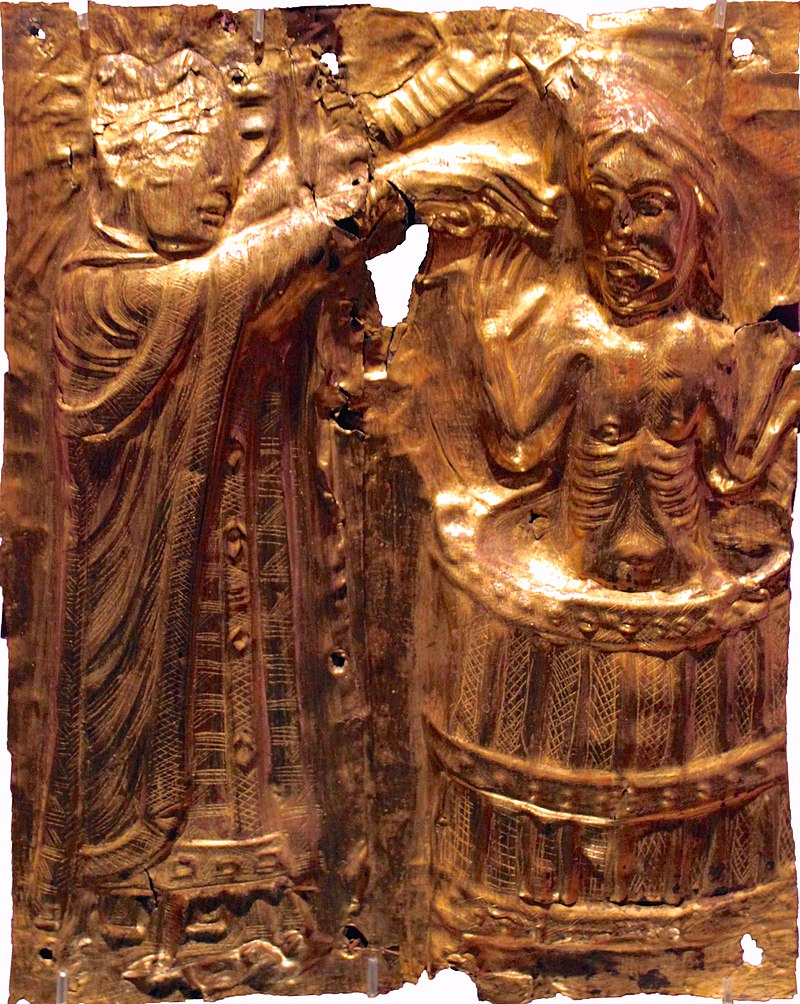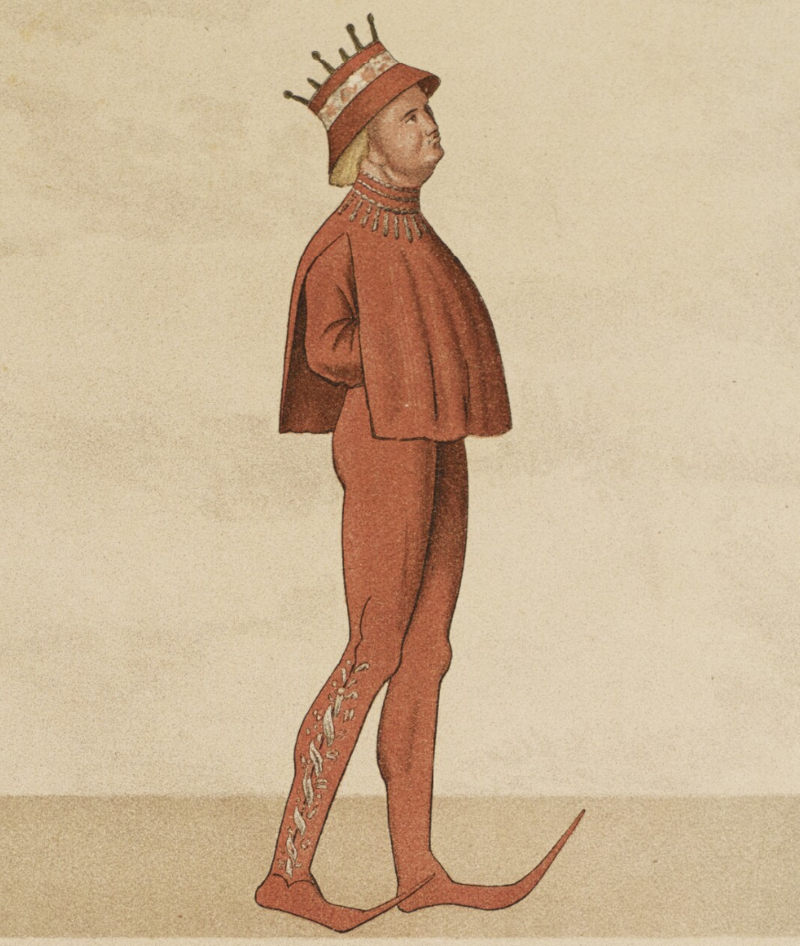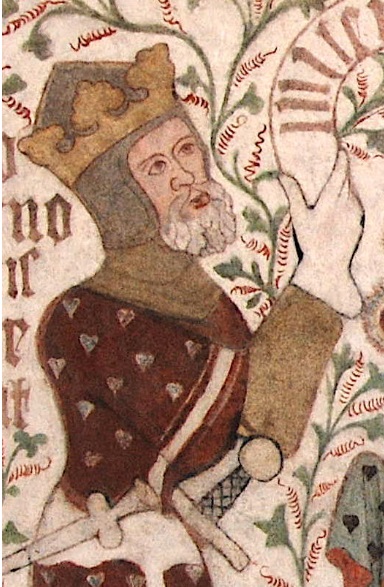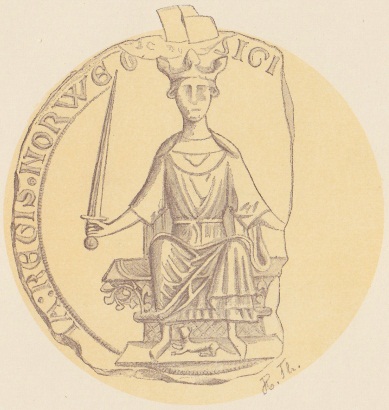by Susan Flantzer
© Unofficial Royalty 2025

Harald III, King of Denmark depicted on his coins with a drawn sword, a show of power; Credit – Wikipedia
King Harald III of Denmark was born circa 1042 and reigned as King of Denmark from 1076 to 1080. He was the first of five illegitimate sons of Sweyn II Estridsson, King of Denmark to become King of Denmark. Harald was called Harald Hen, Runic Danish for Harald the Whetstone with whetstone meaning “the soft one”. Perhaps the nickname originated because Harald was gentle and peaceful by nature and did not always want to impose his own will.

Portrait of Harald’s father King Sweyn II marking his burial place in Roskilde Cathedral in Roskilde, Denmark; Credit – Wikipedia
Harald’s father Sweyn II married twice. His first marriage was childless. According to the chronicle “Jerusalem History”, Sweyn the Crusader, the legitimate son of a King of Denmark, took part in the First Crusade, dying in battle in 1097. Some researchers believe that he was the son of Sweyn II from his second marriage, but there is no documentary evidence of the existence of Sweyn the Crusader. Sweyn the Crusader would have been living when Sweyn II died in 1076. It would seem logical that a legitimate son of Sweyn II would have been considered a candidate to be his successor. However, only his illegitimate sons Harald III, Sweyn II’s successor, and Cnut IV, who succeeded Harald III, were considered.
Sweyn II had many mistresses and fathered at least twenty children. The identity of the mothers of his illegitimate children is uncertain. Sweyn II’s illegitimate children listed below are either Harald III’s full siblings or his half-siblings. “Brother” will be used when discussing Harald’s male siblings but it is unknown whether they were full brothers or half-brothers.
- Knud Magnus (circa 1041 – 1058) – King Sweyn II wanted his eldest son Knud Magnus crowned as his successor by the Pope, but Knud Magnus died on his way to Rome.
- Harald III Hen, King of Denmark (circa 1042 – 1080), was King of Denmark from 1076 to 1080
- (Saint) Cnut IV, King of Denmark (? – 1086)
- Olaf I Hunger, King of Denmark (circa 1050 – 1095)
- Eric I Evergood, King of Denmark (circa 1060 – 1103)
- Svend Tronkræver (? – 1104)
- Ulf Svendsen (Ubbe) (? – 1104)
- Benedict Svendsen (? – 1086)
- Bjørn Svendsen, Duke of Nordalbingien (circa 1062 – 1100)
- Niels, King of Denmark (circa 1065 – 1134)
- Sigrid Svendsdatter (? – after 1066), married (Saint) Prince Gottschalk, who established the Polabian Slavic kingdom in present-day northeastern Germany
- Ingerid Svendsdatter (? – after 1093), wife of King Olav III of Norway
- Thorgils Svendsen
- Sigurd Svendsen, died in the war against the Wends
- Guttorm Svendsen
- Ømund Svendsen
- Ragnhild Svendsdatter, wife of Svein Aslaksson
Harald III married Margareta Asbjørnsdatter, the daughter of Jarl Asbjörn Ulfsen, a Danish nobleman (Jarl was a nobility title), and possibly Harald’s maternal uncle. Margareta’s birth and death dates are unknown, and there are no known children from the marriage.
In 1069, Harald participated in the last Viking invasion of England, attempting to exploit the English people’s dissatisfaction with King William I of England, who in 1066, as Duke of Normandy, invaded England and defeated the last king of the House of Wessex, Harold II Godwinson, at the Battle of Hastings. However, the Viking army was unsuccessful against the stronger Norman army and returned home with nothing accomplished.
When Harald’s father Sweyn II Estridsson, King of Denmark, died in 1076, there were two candidates for the Danish throne, Harald, Sweyn II’s eldest son, and Cnut, Sweyn II’s second son. An assembly of Danish nobles had to choose between the two candidates. Harald was seen as more peaceful, while Cnut wanted to try to reconquer England. To convince the nobles to vote for him, Harald took the vows called Harald’s Laws, declaring that he would uphold the existing rule of law.
Although Harald had conflicts with his brothers Cnut and Eric, his reign was relatively peaceful. He continued his father’s pro-church policies and had a good relationship with Pope Gregory VII. Harald often took the peasants’ side in conflicts between chieftains and peasants. He made the large forests owned by the crown accessible and usable to all, despite protests from the nobles who previously had sole rights.
Harald is particularly known for abolishing the old innocence tests, in which a person accused in a criminal case had to prove their innocence by some ordeal. When Harald came to the throne, the old pagan traditions, such as victory in a duel or trial by fire, were still used to prove innocence or guilt. Harald abolished them and decided that if the accused himself and a certain number of honorable men dared to swear that he was innocent, his innocence was proven.
Harald III, King of Denmark died on April 17, 1080, aged around 38, and was succeeded by his brother, King Cnut IV of Denmark. Harald was buried in Dalby Church, now in Dalby, Sweden. When the church was built, Dalby was part of Denmark. The church was commissioned by Harald’s father Sweyn II and was constructed during the second half of the 11th century.
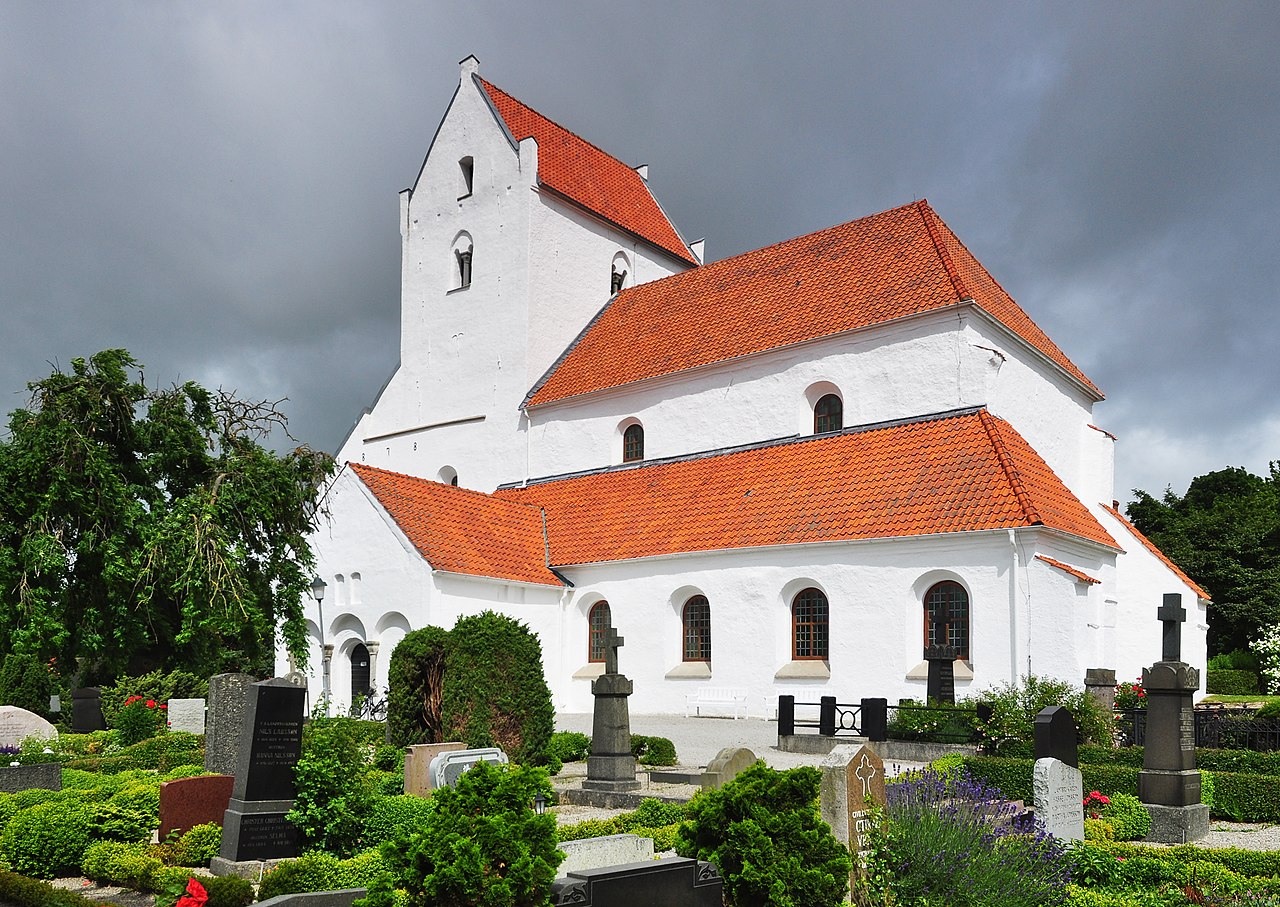
Dalby Church; Credit – Wikipedia
In Dalby Church, the 13th-century apse ends in a Romanesque tombstone with an incised cross, known as Harald’s Stone. No one is buried under the stone, which probably comes from an earlier canon‘s grave. Harald is possibly buried in the southeast corner of the church by the niche in the sacristy.

The niche in Dalby Church where King Harald III may be buried; Credit – By Oleryhlolsson Own work
A 2015 study suggested that King Harald III may have died of Brugada syndrome, a genetic disorder in which the electrical activity in the heart is abnormal. It increases the risk of abnormal heart rhythms and sudden cardiac death. The study showed that perhaps up to fourteen Danish kings who suddenly died at a relatively young age without being ill possibly died of Brugada Syndrome.
This article is the intellectual property of Unofficial Royalty and is NOT TO BE COPIED, EDITED, OR POSTED IN ANY FORM ON ANOTHER WEBSITE under any circumstances. It is permissible to use a link that directs to Unofficial Royalty.
Works Cited
- Bidragsgivare till Wikimedia-projekten. (2005, April 14). Dalby Kyrka. Wikipedia.org; Wikimedia Foundation, Inc. https://sv.wikipedia.org/wiki/Dalby_kyrka
- Bidragsydere til Wikimedia-projekter. (2003). Konge af Danmark (1041-1080). Wikipedia.org; Wikimedia Foundation, Inc. https://da.wikipedia.org/wiki/Harald_Hen
- Flantzer, S. (2025). Sweyn II Estridsson, King of Denmark [Review of Sweyn II Estridsson, King of Denmark]. Unofficial Royalty. https://www.unofficialroyalty.com/sweyn-ii-estridsson-king-of-denmark/
- Hadley, Dawn & Richards, Julian. (2022). The Viking Great Army and the Making of England. Thames & Hudson.
- Wikipedia Contributors. (2024). Harald Hen. Wikipedia; Wikimedia Foundation.




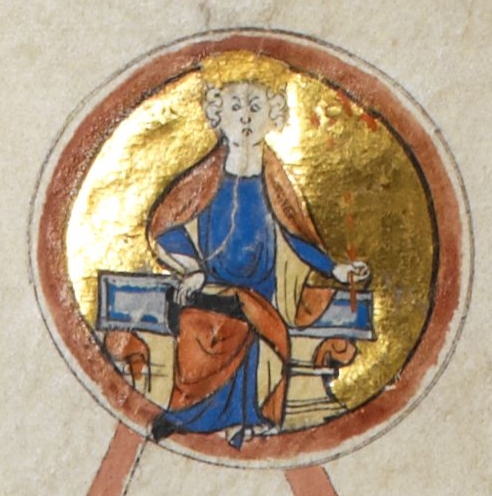





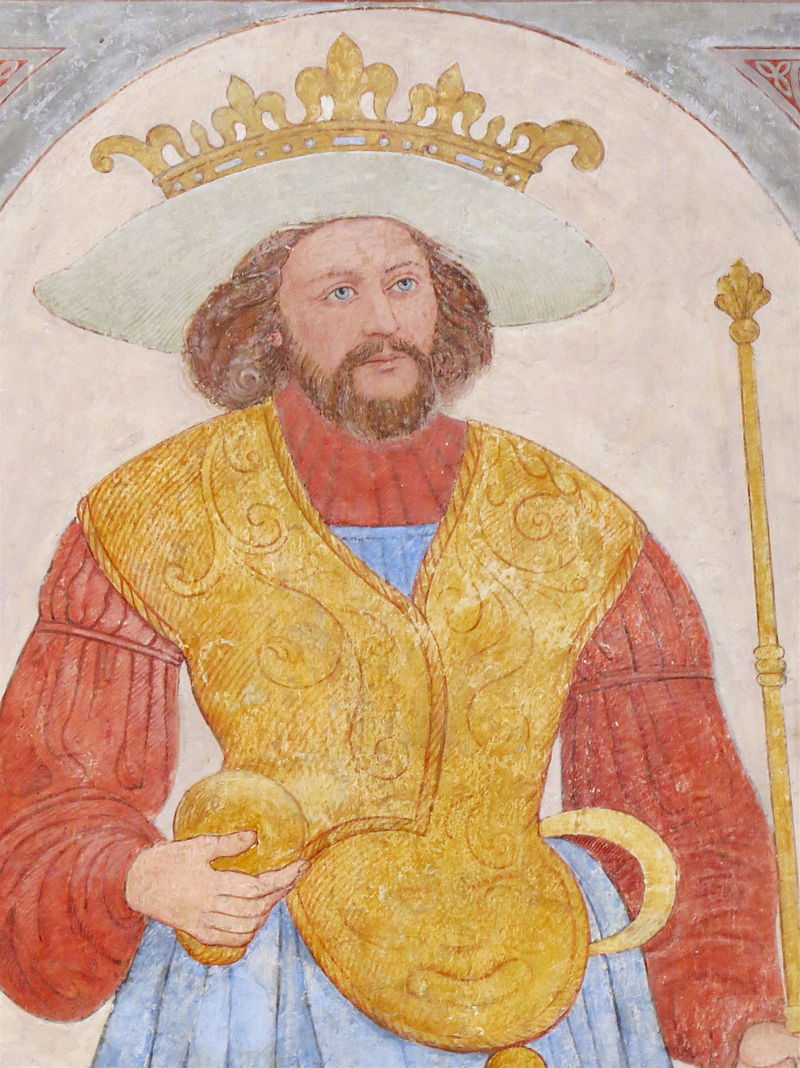
 (
(